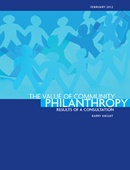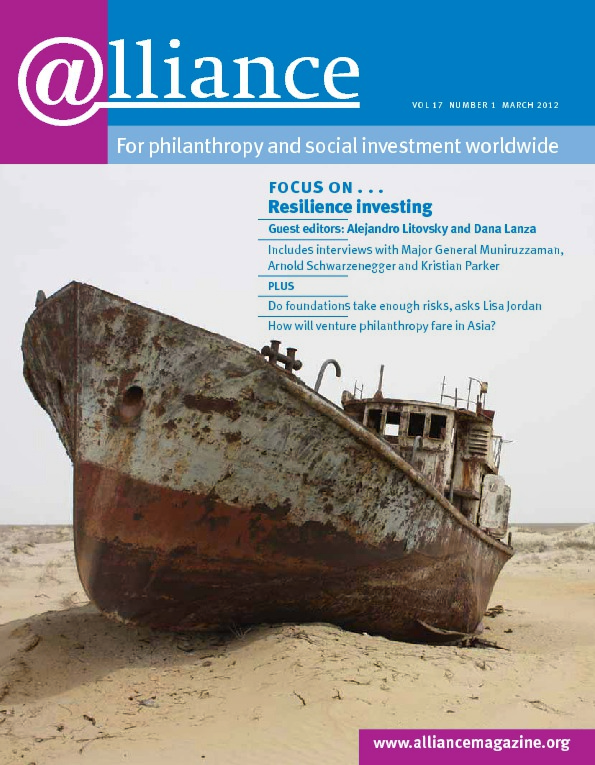Over the past year, the Aga Khan Foundation (USA) and the C S Mott Foundation have consulted the field about how to develop community philanthropy. A new report, The Value of Community Philanthropy, suggests ways of transforming the relationship between donors and beneficiaries to improve the effectiveness of development aid.
 The report is based on a series of consultations in Washington DC, Johannesburg and Dhaka designed to examine the value of community philanthropy as a means of contributing to the sustainability of civil society and supporting the effectiveness of development aid.
The report is based on a series of consultations in Washington DC, Johannesburg and Dhaka designed to examine the value of community philanthropy as a means of contributing to the sustainability of civil society and supporting the effectiveness of development aid.
At the start of the consultation, the general trend did not appear to bode well for such a development. Most foundations now favour a top-down approach, deploying large amounts of money in big grants to solve big problems with specific hard outcomes as the desired results. The rise of ‘philanthrocapitalism’, which takes concepts and techniques from venture capital finance and high technology business management and applies them to achieving philanthropic goals, has reinforced this approach’.[1] The consequence is that a focus on ‘soft outcomes’ in ‘community’ has largely disappeared from the mainstream agenda of large foundations.
A new generation of activist foundations
During the consultation, however, it became evident that, as local neighbourhoods across the world face up to the challenges of climate change, economic recession, retreat of the state and mounting inequality, there is an upsurge of citizen engagement. This has spawned social enterprises, social movements, protest groups, women’s funds and hybrids that defy easy classification.
A new generation of community foundations is part of this trend. Shaped by their particular context and driven by their desire to have their own independent assets, examples include the Community Foundation of South Sinai, Amazon Partnerships Foundation in Ecuador, and Ilha Community Foundation in Mozambique. Some have been on the frontlines of democracy building, as in the case of Waqfeyat al Maadi Community Foundation in Egypt, and in changing mindsets, as with the Dalia Association in Palestine.
The trend is not restricted to the developing world: a new generation of community foundations in the US is also pioneering a participatory approach. Examples include the Black Belt Community Foundation in Alabama and the Foundation for Appalachian Ohio. Although many of these developments are new and small, and take different organizational forms, what makes them important is that local people are both taking the lead and contributing their own money in favour of an inclusive and equitable society.
This new generation of community foundations plays important interstitial roles, building trust between people and institutions, harnessing the power of small grants, building constituencies among people who are oppressed and marginalized, and negotiating the territory between such marginalized groups and governments. They are ‘activist foundations’.
A new relationship between donor and beneficiary
From the perspective of development agencies, the fact that local people contribute their own money is a game changer. It breaks down the hierarchy between donor and beneficiary normally found in development aid relationships. Tewa, for example, which was formed specifically to break down that hierarchy in Nepal, now has 3,000 local donors, which guarantees local ownership of the institution. That local people invest in their own development undoubtedly increases the chances of long-term sustainability. In contrast to many NGOs where donors effectively own them, this confers legitimacy in a way that no amount of external funding ever could.
For the development agency, community philanthropy is an attractive option because it builds on what is already there. There is evidence that an ‘asset approach’ (using what we have to build what we need) is more effective than a ‘needs approach’ (focusing on problems that need to be fixed). Borrowing a metaphor that the Sabanci Foundation uses to define its work, developers should be ‘farmers’ (nurturing the ground and reaping the harvest in the fullness of time) rather than ‘hunters’ (finding the prey and bringing it back home immediately). In sum, community philanthropy enables a new relationship between ‘top-down externally based resources’ and ‘bottom-up internally generated resources’.
Moving to the next stage
Having agreed the uniquely important role that community philanthropy plays in sustaining civil society, and could play in improving the effectiveness of development aid, the consultation moved on to what needs to happen to realize this potential. The main requirement is to join up parts of the field that are presently disconnected, specifically to combine the best features of community philanthropy and international aid to make development more effective.
People worked on practical ways in which community philanthropy could gain recognition as a valuable, necessary and legitimate feature of development practice. They concluded that there are five prerequisites relating to evidence, legitimacy, partnerships, roles and communications.
Evidence
To apply clear definitions and use more rigorous metrics and data analysis to demonstrate what works. Such an approach has not been a high priority and this needs to change. One of the reasons that the field of community philanthropy has not established itself properly has been its inability to sell itself in terms understood by economists. Community philanthropy needs to establish itself as an essential requirement of good development, not a desirable extra.
Legitimacy
To mobilize a critical mass of people as part of a process of participatory democracy in favour of the common good. The field has tended to see its own activity as sufficient justification without demonstrating the legitimacy of that activity. It is important to showcase good examples such as the Kenya Community Development Foundation, which has been a shining beacon of propriety in the 14 years of its existence, providing small, strategic grants and advice to organizations like the Makutano Community Development Association, whose legitimacy is ensured by wide community ownership of its actions, guaranteeing the accountability of leaders to the wider community.
Partnership
To join top-down efforts with the views of beneficiaries so that different interests see what they have in common, particularly by developing horizontal relationships between community organizations to bring the voice of local people to the development table. We can learn from the example of the Community Foundation for Northern Ireland, which has used external money from aid agencies to bring together divided communities while connecting both with marginalized communities and with public authorities and building bridges between them.
Roles
To find complementary roles for different actors to ensure the sustainability of civil society and the effectiveness of development aid. Community philanthropy offers a means of addressing dependency in communities, which tends to occur when the main actors are development agencies and professional NGOs. NGOs need to rediscover the principle of voluntarism, and funders need to support the development of community philanthropy.
Communication
To develop constructive engagement using plain language. The consultations suggested that communication should form a key part of an engagement strategy with a wide range of development actors. Much of the field building of community philanthropy has involved the field talking to itself rather than making the right connections with agencies able to bring the field to scale.
Developing a programme
A programme is currently being devised to tackle these issues systematically and approaches are being made to a number of different funders to take it forward. The Global Fund for Community Foundations will play a part alongside other global partners to ensure that the practice of community philanthropy becomes mainstream. The main outline priorities for the programme are:
- Map successful community philanthropy activities and learn what works about them to strengthen the evidence base of the field.
- Strengthen the international infrastructure for community philanthropy, paying particular attention to organizations like the Global Fund for Community Foundations.
- Support the development of regional networks of community philanthropy organizations and leaders, especially in Asia where the infrastructure is weak.
- Support good practice examples in community philanthropy that have potential for learning and demonstration.
- Influence international development donors to support community philanthropy.
1 Matthew Bishop and Michael Green (2008) Philanthrocapitalism: How the rich can save the world, Bloomsbury.
Barry Knight facilitated the consultations on community philanthropy. Email barryknight@cranehouse.eu
For more information
To download The Value of Community Philanthropy, go to
http://partnershipsinaction.org/communityphilanthropyreport
http://www.mott.org/TheValueofCommunityPhilanthropy





Comments (0)